Addressing Bullying and Teasing | Guide for Mindful Parenting in 2025 - LKG PDF Download
| Table of contents |

|
| Why Kids Bully |

|
| Effective Responses |

|
| To Intervene or Not? |

|
| How to Start |

|
| Handling Problems |

|
| Real-World Example |

|
Why Kids Bully
Bullying and teasing hurt kids and can happen at school, online, or even in the neighborhood. Understanding why kids bully and who they target helps parents and teachers stop it early and support kids who are hurting.
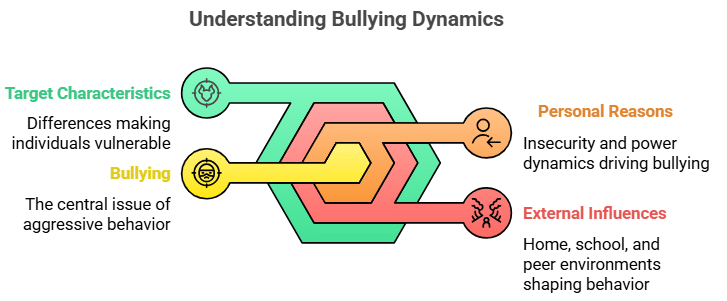
If parents and teachers know why bullying happens, they can spot it early and help kids—both those who are bullied and those who bully—feel safe and supported.
Effective Responses
When bullying or teasing happens, parents and teachers need to act in ways that make kids feel heard, safe, and strong. Here are four simple, effective ways to respond, with detailed examples and strategies for different ages:
1. Don’t Ignore It
Telling kids to “just ignore it” or “toughen up” can make them feel alone and scared. A 2018 study in Pediatrics found that when adults step in to help, bullying does less harm to kids’ mental health over time, reducing anxiety and depression. Ignoring bullying can make kids think no one cares, which hurts their confidence.
- For Younger Kids (5–8): If a 6-year-old says someone called them “weird” at recess, don’t say, “Don’t worry about it.” Instead, say, “That must feel bad. Can you tell me more? Let’s talk to your teacher.” This shows you’re on their side.
- For Older Kids (9–12): If a 10-year-old says they’re being left out of games, listen and say, “That sounds really tough. Let’s figure out how we can help, maybe by talking to your teacher or coach.”
- For Teens (13+): If a teen mentions getting mean comments on Instagram, don’t brush it off with, “Just stay off your phone.” Say, “That’s not okay. Let’s save those comments and tell the school. I’m here for you.”
Tip: Ask specific, gentle questions to learn more, like, “What happened at lunch today?” or “Did anyone say something that made you feel bad?” This helps kids share without feeling judged.
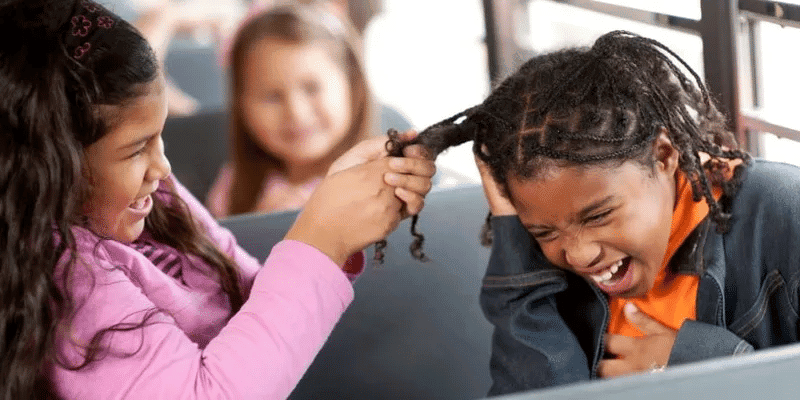
2. Teach Assertiveness
Help kids learn to speak up calmly and confidently. Practice saying phrases like, “Stop, that’s not okay,” or “I don’t like that, please stop.” This gives them tools to stand up for themselves without fighting or making things worse.
- For Younger Kids: With a 5-year-old, role-play a scenario where you pretend to tease them about their toy. Have them say, “That’s not nice, stop it.” Praise them with, “Wow, you sounded so strong!” Practice a few times to build confidence.
- For Older Kids: For a 10-year-old, practice, “I don’t think that’s funny. Stop it.” Act out a scene where they’re teased about their backpack, and show them how to stand tall and use a firm voice.
- For Teens: Help a 14-year-old practice, “Those comments aren’t cool. Cut it out.” Role-play a situation like someone mocking their outfit, and teach them to walk away if the bullying continues.
Tip: Make role-playing fun, like a game. For example, pretend to be a “silly bully” who says goofy things, so kids feel safe practicing. For teens, keep it real but low-pressure, like, “Let’s try what you’d say if someone texts something mean.”
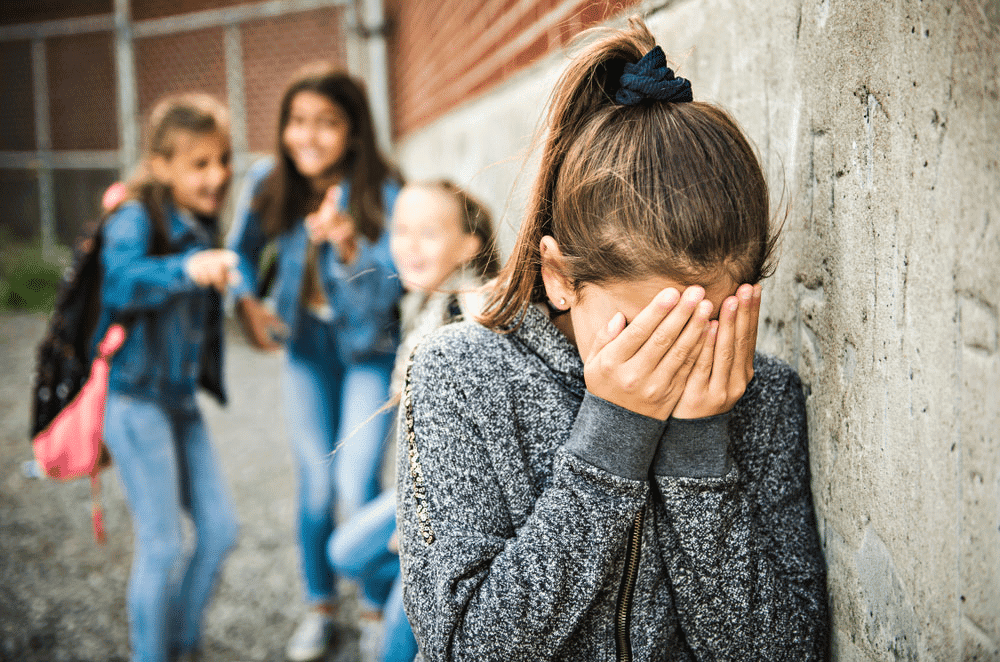
3. Involve Schools
Teachers and school staff can watch how kids act in groups, spot bullying, and use school rules to stop it. Share specific details with them, like, “My child said Jake pushed them at recess.” Schools can monitor, enforce anti-bullying policies, or set up group activities to build kindness.
- For Younger Kids: If a 7-year-old is teased about their lunch, tell the teacher, “Liam says kids are making fun of his food at lunch. Can you watch and maybe talk to the class about kindness?”
- For Older Kids: If an 11-year-old is excluded from a group project, say to the teacher, “Emma feels left out in science class. Can you pair her with others or check the group?” Suggest team-building activities.
- For Teens: If a teen gets mean messages online, tell the school counselor, “Noah’s getting hurtful texts from classmates. Can you look into it and check the school’s cyberbullying rules?”
Tip: Write down what your child tells you, like dates and details (e.g., “On May 25, Mia was teased about her shoes at recess”). Share this with the school for clear follow-up. Check back in a week to ask, “Has the teasing stopped?”

4. Foster Empathy at Home
Teach kids to understand how others feel by talking about kindness and doing caring activities. Reading stories about bullying or helping others, like volunteering, makes kids less likely to tease and more likely to help someone being bullied.
- For Younger Kids: Read The Invisible Boy and ask, “How did Brian feel when no one played with him? What could his friends do?” Practice saying kind things, like, “I like your drawing!”
- For Older Kids: Volunteer together, like sorting clothes for a charity. Ask, “How do you think this helps people? How would you feel if someone helped you?” This builds compassion.
- For Teens: Discuss a book like Wonder and ask, “How did Auggie feel when kids stared at him? What could you do if you saw someone being teased?” Encourage them to stand up for others, like saying, “Leave them alone.”
Tip: Create a “kindness jar” at home. Everyone writes down kind things they did or saw (e.g., “I shared my toy”) and reads them at dinner. This makes kindness a fun family habit.
To Intervene or Not?
A little teasing, like a silly nickname between friends, can teach kids to handle small conflicts and build resilience. But repeated or mean bullying—like daily name-calling, pushing, or online harassment—needs action. A study in Child Abuse & Neglect says ongoing bullying can cause serious problems, like anxiety, depression, or even trouble sleeping and eating.
- Check In Regularly: Ask kids how they’re doing, like, “What’s it like at school? Anyone being mean?” Make it casual so they feel safe sharing. For example, ask at bedtime, “What was the best and worst part of your day?”
- Watch for Signs: Look for changes, like a 6-year-old who’s suddenly scared to go to school, a 10-year-old who’s quiet and stops playing with friends, or a teen who’s always upset after checking their phone. A 2019 study in Journal of Clinical Child & Adolescent Psychology says these can signal bullying.
- When to Step In: If teasing happens once or twice, help kids practice assertive responses or talk to friends themselves. If it’s constant—like daily insults or being left out—act fast by talking to the school or parents. For example, if a child is teased every day about their weight, tell the teacher and ask for a plan.
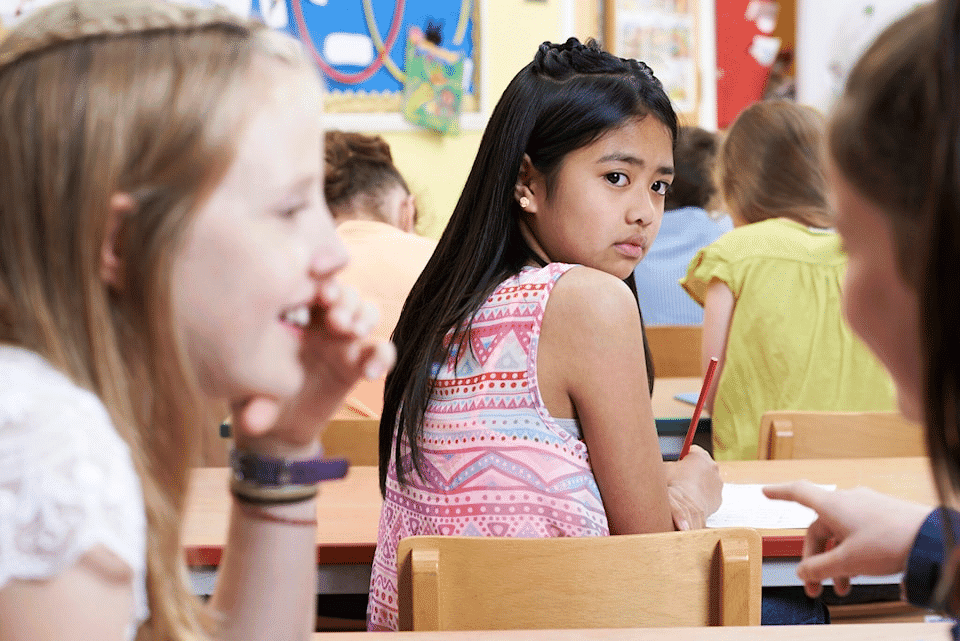
Added Detail: Bullying can affect kids for years. A study in Pediatrics found that kids bullied in elementary school are more likely to struggle with self-esteem or trust as teens and adults. Early action prevents long-term harm and teaches kids they’re worth protecting.
Tip: Keep a journal of what your child says about bullying, like, “On May 28, Tom said kids laughed at his shirt.” This helps you track patterns and share details with the school or counselor.
How to Start
You don’t need to do everything at once. Here’s a detailed plan to start helping with bullying, with practical steps:
- Ask About Their Day: Today, ask, “Did anything fun or tough happen at school? Anyone being unkind?” Listen without interrupting, even if they share something small, like a mean comment.
- Practice Assertiveness: Spend 5–10 minutes role-playing. Pretend to be a bully and have your kid say, “Stop, that’s not okay.” Praise them, like, “You sounded so brave!” Do this a few times a week.
- Talk to School: If you hear about bullying, tell the teacher or counselor specific details, like, “My child says kids are teasing them about their lunch every day.” Ask, “What can we do to stop this?” Follow up in a week.
- Build Empathy: Read a book about kindness, like Have You Filled a Bucket Today? for young kids or Fish in a Tree for older ones. Ask, “How did the character feel? What would you do?” Or do a kind act, like donating toys, and talk about it.
- Check In Often: Once a week, ask, “How’s school going? Any problems with friends?” Watch for signs like sadness, anger, or avoiding school.
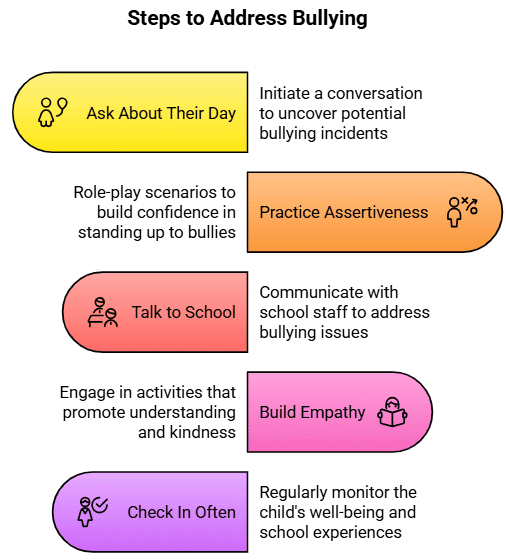
Handling Problems
Addressing bullying can be tough. Here are common challenges and how to handle them, with extra details:
- Kids Won’t Talk: If kids don’t share, don’t push. Say, “I’m always here if you want to talk about school or friends.” A study in Journal of Youth and Adolescence says kids open up more when they feel safe, not pressured. Try asking during a calm moment, like while driving or eating.
- Bullying Keeps Happening: If the school doesn’t act, ask for a meeting with the principal or counselor. Bring specific examples, like, “On May 20 and 22, kids teased Ava about her braces.” Ask for a clear plan, like extra supervision or a school-wide kindness program.
- Cyberbullying: If bullying happens online, save texts, posts, or screenshots as evidence. Tell the school and help your kid block the bully on apps. For example, show a teen how to block someone on Instagram.
- Different Ages: Younger kids might cry or cling when bullied, so give hugs and simple words, like, “I’ll help you.” Older kids might act angry or withdraw, so ask, “What’s been tough lately?” Teens might hide feelings but spend too much time online, so say, “I notice you seem upset after checking your phone. Want to talk?”
- If Your Kid Bullies: If your child is teasing others, don’t just punish. Ask, “What happened? How do you think they felt?” Help them fix it, like writing an apology or doing something kind.
- Time Limits: If you’re busy, focus on quick check-ins, like a 5-minute talk after school. Teachers can watch for bullying during high-risk times, like recess or lunch, when 60% of bullying happens, per a 2024 study in Journal of School Health.
Real-World Example
Imagine your 9-year-old says kids are teasing them about their new glasses. Try this:
- Step 1: Don’t Ignore It: Say, “That sounds really hurtful. Can you tell me what they said? We’ll figure this out together.”
- Step 2: Teach Assertiveness: Role-play, “I like my glasses, please stop.” Practice until they feel confident, and say, “You’re so strong for speaking up!”
- Step 3: Involve School: Tell the teacher, “Kids are calling Zoe ‘four-eyes’ at lunch. Can you watch and maybe talk to the class about respecting differences?”
- Step 4: Foster Empathy: Read The Invisible Boy and ask, “How did he feel when left out? What could you do to help someone?” Encourage Zoe to compliment a classmate.
For a Younger Kid (6 years old): If they’re teased about their backpack, say, “That must feel bad.” Practice, “My backpack’s cool, stop it.” Tell the teacher, “Kids are teasing Max about his bag.” Read Chrysanthemum to talk about kindness.
For a Teen (14 years old): If they’re getting mean Snapchats, say, “That’s not okay. Let’s save those messages.” Practice, “Those snaps aren’t cool. Stop.” Tell the counselor, “Liam’s getting hurtful messages.” Discuss Wonder and ask, “How can we help others feel included?”
|
10 docs|2 tests
|
FAQs on Addressing Bullying and Teasing - Guide for Mindful Parenting in 2025 - LKG
| 1. Why do kids bully others? |  |
| 2. What are effective responses to bullying? |  |
| 3. Should I intervene if I witness bullying? |  |
| 4. How can I start addressing bullying in my school? |  |
| 5. Can you provide a real-world example of addressing bullying? |  |















